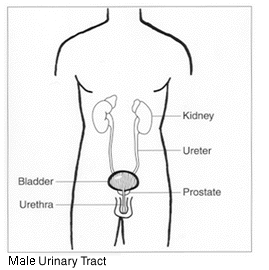Bladder Cancer
Introduction:
This page has important information about cancer* of the bladder. Each year in the United States, bladder cancer is diagnosed in 38,000 men and 15,000 women. This is the fourth most common type of cancer in men and the eighth most common in women.
This booklet discusses possible causes, symptoms, diagnosis, treatment, and rehabilitation. It also has information to help patients cope with bladder cancer.
Research is increasing what we know about bladder cancer. Scientists are learning more about its causes. They are exploring new ways to prevent, detect, diagnose, and treat this disease. Because of research, people with bladder cancer have an improved quality of life and less chance of dying from this disease.
The Bladder
The bladder is a hollow organ in the lower abdomen. It stores urine, the liquid waste produced by the kidneys. Urine passes from each kidney into the bladder through a tube called a ureter.
An outer layer of muscle surrounds the inner lining of the bladder. When the bladder is full, the muscles in the bladder wall can tighten to allow urination. Urine leaves the bladder through another tube, the urethra.

Understanding Cancer
Cancer is a group of many related diseases. All cancers begin in cells, the body's basic unit of life. Cells make up tissues, and tissues make up the organs of the body.
Normally, cells grow and divide to form new cells as the body needs them. When cells grow old and die, new cells take their place.
Sometimes this orderly process goes wrong. New cells form when the body does not need them, and old cells do not die when they should. These extra cells can form a mass of tissue called a growth or tumor.
Tumors can be benign or malignant:
- Benign tumors are not cancer. Usually, doctors can remove them. Cells from benign tumors do not spread to other parts of the body. In most cases, benign tumors do not come back after they are removed. Most important, benign tumors are rarely a threat to life.
- Malignant tumors are cancer. They are generally more serious. Cancer cells can invade and damage nearby tissues and organs. Also, cancer cells can break away from a malignant tumor and enter the bloodstream or the lymphatic system. That is how cancer cells spread from the original (primary) tumor to form new tumors in other organs. The spread of cancer is called metastasis
There are three types of bladder cancer that begin in cells in the lining of the bladder. These cancers are named for the type of cells that become malignant:
- Transitional cell carcinoma: Cancer that begins in cells in the innermost tissue layer of the bladder. These cells are able to stretch when the bladder is full and shrink when it is emptied. Most bladder cancers begin in transitional cells.
- Squamous cell carcinoma: Cancer that begins in squamous cells, which are thin, flat cells that may form in the bladder after a long- term infection or irritation.
- Adenocarcinoma: Cancer that begins in glandular (secretory) cells that may form in the bladder after a long-term inflammation or irritation.
Cancer that is only in cells in the lining of the bladder is called superficial bladder cancer. The doctor might call it carcinoma in situ. This type of bladder cancer often comes back after treatment. If this happens, the disease most often recurs as another superficial cancer in the bladder.
Cancer that begins as a superficial tumor may grow through the lining and into the muscular wall of the bladder. This is known as invasive cancer. Invasive cancer may extend through the bladder wall. It may grow into a nearby organ such as the uterus or vagina (in women) or the prostate gland (in men). It also may invade the wall of the abdomen.
When bladder cancer spreads outside the bladder, cancer cells are often found in nearby lymph nodes. If the cancer has reached these nodes, cancer cells may have spread to other lymph nodes or other organs, such as the lungs, liver, or bones.
When cancer spreads (metastasizes) from its original place to another part of the body, the new tumor has the same kind of abnormal cells and the same name as the primary tumor. For example, if bladder cancer spreads to the lungs, the cancer cells in the lungs are actually bladder cancer cells. The disease is metastatic bladder cancer, not lung cancer. It is treated as bladder cancer, not as lung cancer. Doctors sometimes call the new tumor "distant" disease.
Bladder Cancer: Who's at Risk?
No one knows the exact causes of bladder cancer. However, it is clear that this disease is not contagious. No one can "catch" cancer from another person.
People who get bladder cancer are more likely than other people to have certain risk factors. A risk factor is something that increases a person's chance of developing the disease.
Still, most people with known risk factors do not get bladder cancer, and many who do get this disease have none of these factors. Doctors can seldom explain why one person gets this cancer and another does not.
Studies have found the following risk factors for bladder cancer:
- Age. The chance of getting bladder cancer goes up as people get older. People under 40 rarely get this disease.
- Tobacco. The use of tobacco is a major risk factor. Cigarette smokers are two to three times more likely than nonsmokers to get bladder cancer. Pipe and cigar smokers are also at increased risk.
- Occupation. Some workers have a higher risk of getting bladder cancer because of carcinogens in the workplace. Workers in the rubber, chemical, and leather industries are at risk. So are hairdressers, machinists, metal workers, printers, painters, textile workers, and truck drivers.
- Infections. Being infected with certain parasites increases the risk of bladder cancer. These parasites are common in tropical areas but not in the United States.
- Treatment with cyclophosphamide or arsenic. These drugs are used to treat cancer and some other conditions. They raise the risk of bladder cancer.
- Race. Whites get bladder cancer twice as often as African Americans and Hispanics. The lowest rates are among Asians.
- Being a man. Men are two to three times more likely than women to get bladder cancer.
- Family history. People with family members who have bladder cancer are more likely to get the disease. Researchers are studying changes in certain genes that may increase the risk of bladder cancer.
- Personal history of bladder cancer. People who have had bladder cancer have an increased chance of getting the disease again
Chlorine is added to water to make it safe to drink. It kills deadly bacteria. However, chlorine by-products sometimes can form in chlorinated water. Researchers have been studying chlorine by-products for more than 25 years. So far, there is no proof that chlorinated water causes bladder cancer in people. Studies continue to look at this question.
Some studies have found that saccharin, an artificial sweetener, causes bladder cancer in animals. However, research does not show that saccharin causes cancer in people.
People who think they may be at risk for bladder cancer should discuss this concern with their doctor. The doctor may suggest ways to reduce the risk and can plan an appropriate schedule for checkups.
Symptoms
Common symptoms of bladder cancer include:
- Blood in the urine (making the urine slightly rusty to deep red),
- Pain during urination, and
- Frequent urination, or feeling the need to urinate without results.
These symptoms are not sure signs of bladder cancer. Infections, benign tumors, bladder stones, or other problems also can cause these symptoms. Anyone with these symptoms should see a doctor so that the doctor can diagnose and treat any problem as early as possible. People with symptoms like these may see their family doctor or a urologist, a doctor who specializes in diseases of the urinary system.





































